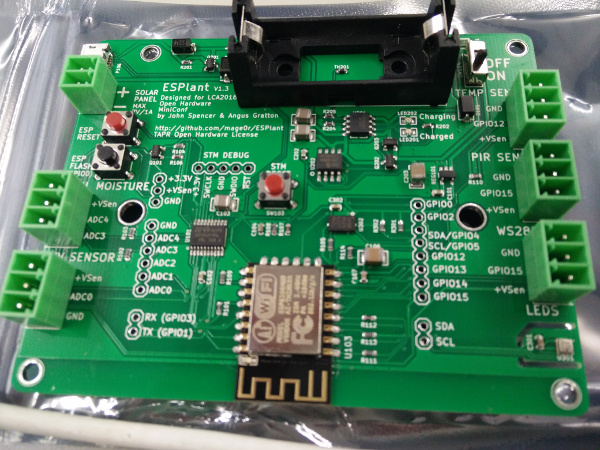ESPlant - Open Hardware Miniconf - LCA2016
Today at Linux Conference Australia 2016 or "LCA by the Bay" in Geelong, I attended the Open Hardware miniconf for the first time after a number of years of wanting to attend but being unable to.
This year they were making an ESPlant (Environment Sensor Plant), which is kind of timely.
The solar powered plant we're building has the following sensors:
- BME280 Temperature/Humidity/Barometric Pressure sensor
- 2 soil moisture sensors
- DS18B20 temperature sensor
- PIR (infrared motion) sensor (in case your plants are running away from something)
- ADXL345 accelerometer (to see how fast your plants are running away)
- WS2812B LED strip
- UV sensor SEN0162 from DF Robot.


It only took about 30 minutes to assemble, and it looked like this on my desk:

This was an enjoyable and extremely productive hardware hacking session. I am going to have some of these all over our gardens and they will look something like this but with added weather shields:

I intend to hook the moisture sensors into the watering system so that water is delivered when soil moisture levels reach a pre-determined low point and stopped once they reach a desired saturation point. I want to maximise the efficiency of water consumption and I think this should help.
Sample raw serial output from the ESPlant:
temp = 26.22
pressure = 1005.65
humidity = 43.34
acc/x = 0.04 acc/y = -0.35 acc/z = 10.04
adc/uv_sensor = 0
adc/soil_1 = 91
adc/soil_2 = 38
adc/input_voltage = 4398
adc/internal_temp = 1656
external/temp_sensor = 24.00
chip/free_heap = 47120
chip/vcc = 3431
pir = low
led = 6
This data could also be fed into some long term graphing on my server via it's WiFi chip.